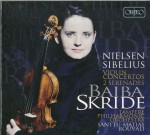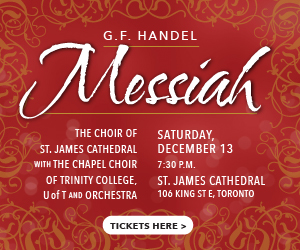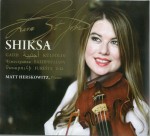 When you listen to the simply astonishing opening track of Shiksa, the new CD from violinist Lara St. John and pianist/composer Matt Herskowitz on St. John’s own Ancalagon label (ANC 143 larastjohn.com/ancalagon) you could be forgiven for thinking that the rest of the CD couldn’t possibly match up – but you would be wrong!
When you listen to the simply astonishing opening track of Shiksa, the new CD from violinist Lara St. John and pianist/composer Matt Herskowitz on St. John’s own Ancalagon label (ANC 143 larastjohn.com/ancalagon) you could be forgiven for thinking that the rest of the CD couldn’t possibly match up – but you would be wrong!
The Czardashian Rhapsody is Martin Kennedy’s fiendishly difficult take on the traditional Czardas, with hints of Liszt’s Hungarian Rhapsody No.2 thrown in for good measure. It’s stunning, but there’s much more to come in this program of predominantly Middle Eastern and Eastern European music. All 14 tracks are based on traditional material, and feature creative arrangements by Milica Paranosic, John Kameel Farah, Yuri Boguinia, Serouj Kradjian, David Ludwig, Gene Pritsker, John Psathas, Michael P. Atkinson and the two performers themselves. Herskowitz’s Nagilara, his own take on Hava Nagila, is another showstopper, as is St. John’s Oltenian Hora, a dazzling display of what she calls “a bunch of improvised Romanian violin tricks, twists and turns.”
These are all much more than just mere showpieces though, and in many instances they clearly have personal resonance for both the composers and performers. What is truly remarkable is the way in which St. John effortlessly and completely captures the sound, style, mood and flavour of these evocative works; Shiksa may be a Yiddish term for a non-Jewish woman, but there’s no hint here of St. John’s being an outsider or anything other than totally and genuinely immersed in this music – you get the feeling that she’s playing these pieces from the inside out. The recorded sound, especially for the piano, is superb – hardly surprising, given that the recording was made in the beautiful acoustics of Le Domaine Forget de Charlevoix in Saint-Irénée, Québec.
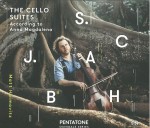 I’ve noted before that it’s almost impossible to do comparative reviews of Bach’s unaccompanied violin and cello works; all you can do is look at the performer’s approach and the creative process and report on the result. Luckily, cellist Matt Haimovitz has virtually done this for us in his new 2-CD set of J. S. Bach: The Cello Suites According to Anna Magdalena (PentaTone Oxingale Series PTC 5186 555). In the extensive booklet essay Haimovitz details his journey so far with these wonderful and challenging works, starting with his hearing the legendary 1930s Casals recordings when he was nine, having a teacher at the time who had been a pupil of Casals and who required Haimovitz to play two movements of Bach each day as part of his regular practice routine, and having the privilege in his mid-teens of playing the Goffriller cello used by Casals.
I’ve noted before that it’s almost impossible to do comparative reviews of Bach’s unaccompanied violin and cello works; all you can do is look at the performer’s approach and the creative process and report on the result. Luckily, cellist Matt Haimovitz has virtually done this for us in his new 2-CD set of J. S. Bach: The Cello Suites According to Anna Magdalena (PentaTone Oxingale Series PTC 5186 555). In the extensive booklet essay Haimovitz details his journey so far with these wonderful and challenging works, starting with his hearing the legendary 1930s Casals recordings when he was nine, having a teacher at the time who had been a pupil of Casals and who required Haimovitz to play two movements of Bach each day as part of his regular practice routine, and having the privilege in his mid-teens of playing the Goffriller cello used by Casals.
The year 2000 saw Haimovitz perform all six suites in Germany, relying primarily on the Bärenreiter edition and the manuscript copy by Anna Magdalena Bach, the composer’s wife – Bach’s original manuscript has never been found. On his return, he launched the new Oxingale Records label with a 3-CD set of the suites, only to find that within a few years he could no longer agree with his interpretations.
Since then he has turned increasingly to the Anna Magdalena manuscript, which he feels is closest in spirit to the original and provides many keys to the playing style and interpretation. He discusses these in detail in the essay.
The performances here, needless to say, are an absolute delight. The cello used is a Matteo Goffriller made in Venice in 1710, with a cello piccolo by the 18th-century maker Georg Nicol. Köllmer used for the Suite V; the bow is a baroque replica made by David Hawthorne. Tuning is A=415 and not the current A=440, so the suites are all down a semi-tone from present-day pitch.
Haimovitz says that “with humility, and no small dose of courage, I continue on my journey with Bach and The Cello Suites, studying the gospel according to Anna Magdalena.” I just hope he continues to take us along with him.
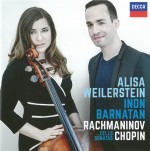 Following her solo recital disc and CDs of the Dvořák, Elgar and Carter cello concertos the latest CD from American Alisa Weilerstein – Rachmaninov & Chopin: Cello Sonatas (Decca 478 8416) with the New York-based Israeli pianist Inon Barnatan shows just how much she has to offer in the chamber music field. From the opening bars of the Rachmaninov Cello Sonata in G Minor, Op.19 it’s clear that this is going to be gloriously expansive playing from both performers. Barnatan is simply superb at the keyboard, with a beautifully judged use of legato in the long, flowing Rachmaninov phrases, and Weilerstein displays the qualities so often mentioned in reviews of her playing: technique, passion and intensity. It’s a captivating and engrossing performance.
Following her solo recital disc and CDs of the Dvořák, Elgar and Carter cello concertos the latest CD from American Alisa Weilerstein – Rachmaninov & Chopin: Cello Sonatas (Decca 478 8416) with the New York-based Israeli pianist Inon Barnatan shows just how much she has to offer in the chamber music field. From the opening bars of the Rachmaninov Cello Sonata in G Minor, Op.19 it’s clear that this is going to be gloriously expansive playing from both performers. Barnatan is simply superb at the keyboard, with a beautifully judged use of legato in the long, flowing Rachmaninov phrases, and Weilerstein displays the qualities so often mentioned in reviews of her playing: technique, passion and intensity. It’s a captivating and engrossing performance.
The high standard continues through the Vocalise, Op.34 No.14 to the Chopin Cello Sonata in G Minor, Op.65, written mostly during the composer’s last summer on his lover George Sand’s estate in Nohant. The first movement in particular clearly gave Chopin a great deal of trouble, and was dropped for the premiere performance. It’s a strong, turbulent work very similar in mood to the Rachmaninov, and the two make an ideal pairing here.
The sonata was dedicated to the French cellist Auguste Franchomme, who gave the first (albeit truncated) performance in 1848 in Chopin’s final public concert. It was Franchomme who arranged the Étude in C-Sharp Minor, Op.25 No.7 for cello and piano, one of two shorter Chopin works on the CD. The Introduction & Polonaise Brillante in C Major, Op.3 dates mostly from Chopin’s youth – the Introduction was added later for Franchomme – and provides a lovely end to a truly beautiful CD.
Review
The Sibelius & Nielsen Violin Concertos make an excellent and natural pairing on the new 2-CD set from Latvian violinist Baiba Skride, with Finland’s Tampere Philharmonic Orchestra under Santtu-Matias Rouvali (Orfeo C 896 152 A). Both composers were born in 1865; both were violinists; both became the leader of their respective country’s Nationalist musical movement; and the concertos were written within a few years of each other in the first decade of the 20th century.
Skride is terrific in the Sibelius, with her rather fast and somewhat narrow vibrato providing a steely edge to the lush tone and phrasing and giving the work a real Nordic feel. The Two Serenades for Violin and Orchestra Op.69 complete the first disc; written in 1912-13, they are not heard all that often, and are a welcome addition here.
The Nielsen concerto is a lovely work that should really be more widely known; indeed, Nielsen’s music in general has never quite gained the recognition outside of his native Denmark that it deserves. In this case it may be the length and shape of the work that’s to blame: it’s almost 40 minutes long, and although ostensibly in four movements is actually in two sections, with the brief first and third “movements” – the latter the only slow movement – acting more as introductions for each half. Also, the simply glorious theme that appears after the brief flourish at the beginning of the work never reappears, and nothing else quite matches it. The performance here is outstanding, though.
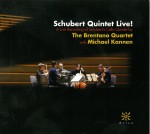 Although leaving the group within eight years of its inception in 1992 the Brentano String Quartet’s founding cellist, Michael Kannen, continued his association with the ensemble, joining them on second cello in numerous performances of Schubert’s String Quintet in C Major D956 over the years, always harboring the hope that he would be able to record it with them one day. In September 2014 his wish came true in a quite exquisite way when the Brentano Quartet decided to make a live recording of the work at Amherst College in Massachusetts. An interactive weekend was built around three performances over three days, and the result was the new CD Schubert Quintet Live! (Azica ACD-71304).
Although leaving the group within eight years of its inception in 1992 the Brentano String Quartet’s founding cellist, Michael Kannen, continued his association with the ensemble, joining them on second cello in numerous performances of Schubert’s String Quintet in C Major D956 over the years, always harboring the hope that he would be able to record it with them one day. In September 2014 his wish came true in a quite exquisite way when the Brentano Quartet decided to make a live recording of the work at Amherst College in Massachusetts. An interactive weekend was built around three performances over three days, and the result was the new CD Schubert Quintet Live! (Azica ACD-71304).
The booklet notes include fascinating reflections on the recording challenges by Alan Bise, the producer and mix engineer for the project, as well as reflections on the performances by Kannen and violinist Mark Steinberg. Bise says that any minor blemishes had to be left in where fixing them would spoil the musical feel of a section, but he notes that “the energy and spirit represented here are almost impossible to capture in a closed recording session without an audience.” Other than the applause at the end there is very little to signify the physical presence of an audience, but the energy and spirit that Bise noted, and that they helped to create, clearly make a major contribution to the emotional effect of the music. It is indeed a wonderful performance of one of the greatest works in the chamber music repertoire.
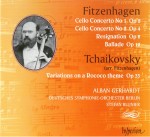 The outstanding Hyperion series The Romantic Cello Concerto reaches Volume 7 with works by the German composer and cellist Wilhelm Fitzhagen (1848-1890), featuring cellist Alban Gerhardt and the Deutsches Symphonie-Orchester Berlin under Stefan Blunier (CDA68063). Fitzhagen was apparently mostly self-taught as a composer, but his two concertos for his instrument are solid, competent and attractive works very much in the German style of the period. The Concerto No.1 in B Minor, Op.2 and the Concerto No.2 in A Minor, Op.4 “Fantastique” are both early works, from 1870 and 1871 respectively, round about the time that Fitzhagen became professor of cello at the Imperial Conservatoire in Moscow. The First Concerto is a short work in three movements played without a break; a dazzling and challenging cadenza at the end of the first movement leads into a very brief (just over three minutes) but lyrical and simply beautiful Andante. The Second Concerto is also quite short, but again displays Fitzhagen’s fluently melodic style.
The outstanding Hyperion series The Romantic Cello Concerto reaches Volume 7 with works by the German composer and cellist Wilhelm Fitzhagen (1848-1890), featuring cellist Alban Gerhardt and the Deutsches Symphonie-Orchester Berlin under Stefan Blunier (CDA68063). Fitzhagen was apparently mostly self-taught as a composer, but his two concertos for his instrument are solid, competent and attractive works very much in the German style of the period. The Concerto No.1 in B Minor, Op.2 and the Concerto No.2 in A Minor, Op.4 “Fantastique” are both early works, from 1870 and 1871 respectively, round about the time that Fitzhagen became professor of cello at the Imperial Conservatoire in Moscow. The First Concerto is a short work in three movements played without a break; a dazzling and challenging cadenza at the end of the first movement leads into a very brief (just over three minutes) but lyrical and simply beautiful Andante. The Second Concerto is also quite short, but again displays Fitzhagen’s fluently melodic style.
The central track on the CD is Tchaikovsky’s Variations on a Rococo Theme Op.33 from 1877. On moving to Moscow Fitzhagen had quickly established himself as a cellist, and soon came to know Tchaikovsky, who dedicated the Variations to Fitzhagen and sent him the manuscript for his comments. The cellist went a good deal further, making cuts and tempo changes, adding his own passages and changing the order of three of the variations. Somewhat reluctantly, Tchaikovsky let the radically altered version stand, and it is the work for which Fitzhagen is most remembered.
Fitzhagen’s Ballade – Concertstück Op.10, a single-movement work which is longer than the First Concerto, and Resignation – Ein geistliches Lied ohne Worte Op.8, a very brief but simply lovely piece, round out the CD.
Alban Gerhardt has been the soloist on five of the seven releases in this terrific series that never fails to delight and impress, and he is once again in his element with this music.
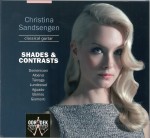 Shades & Contrasts is a quite stunning debut CD from the Norwegian guitarist Christina Sandsengen (Odradek ODRCD326 odradek-records.com). Standard works by Albéniz, Tárrega, Aguado and Agustin Barrios Mangoré are mixed with contemporary works by Sven Lundestad, Carlo Domeniconi and Egberto Gismonti in a varied and highly impressive recital. These are outstanding performances, delivered with a flawless technique and sumptuous tone. Expect to hear a lot more of this artist.
Shades & Contrasts is a quite stunning debut CD from the Norwegian guitarist Christina Sandsengen (Odradek ODRCD326 odradek-records.com). Standard works by Albéniz, Tárrega, Aguado and Agustin Barrios Mangoré are mixed with contemporary works by Sven Lundestad, Carlo Domeniconi and Egberto Gismonti in a varied and highly impressive recital. These are outstanding performances, delivered with a flawless technique and sumptuous tone. Expect to hear a lot more of this artist.
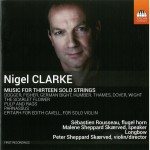 The English composer Nigel Clarke (b.1960) is featured on Music for Thirteen Solo Strings, a new CD from Toccata Classics with the 13-member string ensemble Longbow under the direction of violinist Peter Sheppard Skærved (TOCC 0325). Clarke and Skærved have enjoyed a close collaboration for almost 30 years. Their shared interest in music for divided strings (as opposed to string ensembles working in sections) led to Parnassus for Thirteen Solo Strings in 1986. It’s music that sounds a bit chaotic at first, but soon bears out Skærved’s observation that the frictional interchange between adjacent players playing contrary but related material can produce a sort of ensemble “fire-making” that generates a good deal of instrumental energy; there’s energy here in abundance.
The English composer Nigel Clarke (b.1960) is featured on Music for Thirteen Solo Strings, a new CD from Toccata Classics with the 13-member string ensemble Longbow under the direction of violinist Peter Sheppard Skærved (TOCC 0325). Clarke and Skærved have enjoyed a close collaboration for almost 30 years. Their shared interest in music for divided strings (as opposed to string ensembles working in sections) led to Parnassus for Thirteen Solo Strings in 1986. It’s music that sounds a bit chaotic at first, but soon bears out Skærved’s observation that the frictional interchange between adjacent players playing contrary but related material can produce a sort of ensemble “fire-making” that generates a good deal of instrumental energy; there’s energy here in abundance.
The other four works on the CD are all from the past three years, two of them the result of an artistic collaboration with Dover Arts Development in Clarke’s home county of Kent and two of them tributes to Edith Cavell, the English nurse shot by the Germans in the First World War. Dogger, Fisher, German Bight, Humber, Thames, Dover, Wight, for Speaker, Thirteen Solo Strings and Sound Design is described as a diptych, Clarke’s music being preceded by a lengthy poem sketching Dover’s history written and delivered by Skærved’s wife, the Danish writer Malene Skærved. The title will have immediate meaning for anyone who has ever listened to the Shipping Forecast on BBC Radio; the seven names are of the sea areas from off the eastern coast of England, around the southeast corner and along the south coast past Dover. The music has clear – and self-confessed – references to sea music, including Britten’s Four Interludes from Peter Grimes and Debussy’s La Mer. The Navy Hymn (Eternal father, strong to save) emerges from the chaos of a storm to guide the piece to a serene and mostly tonal ending. Pulp and Rags, also linked to a Malene Skærved poem (not quoted), was inspired by the machinery in Buckland Paper Mill, an old mill near Dover that closed in 2000 after 230 years.
The Scarlet Flower for Flugel Horn and Thirteen Solo Strings features soloist Sébastien Rousseau in a work written as a memorial to Edith Cavell, the opening horn solo later being reworked for solo muted violin as Epitaph for Edith Cavell, with which Skærved closes an intriguing disc.
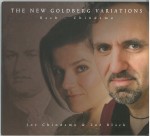 The New Goldberg Variations, a CD from the Australian duo of composer/pianist Joe Chindamo and violinist Zoe Black (Alfire Records ALFI15002) is described as “J. S. Bach’s original and complete Goldberg Variations with a newly composed counterpart for violin.” The violin part was written by Chindamo at Black’s request, and Chindamo says that the only self-imposed rule was that he would not alter a single note Bach wrote, and that he would adhere to Bach’s language and aesthetic.
The New Goldberg Variations, a CD from the Australian duo of composer/pianist Joe Chindamo and violinist Zoe Black (Alfire Records ALFI15002) is described as “J. S. Bach’s original and complete Goldberg Variations with a newly composed counterpart for violin.” The violin part was written by Chindamo at Black’s request, and Chindamo says that the only self-imposed rule was that he would not alter a single note Bach wrote, and that he would adhere to Bach’s language and aesthetic.
The first Variation offers a continuous violin line as opposed to an occasional commentary, and from then on there’s a tendency for the violin to become the primary listening focus, although it does assume a background role quite often. One thing is clear – any misgivings you may have about the project are certainly not the result of any lack of quality in the writing or playing of the violin part; both are done with consummate skill. It’s all beautifully played, with a clean, bright and warm violin sound, and plenty of thoughtful keyboard work which, ironically, made me want to hear what Chindamo would do with the original Goldberg Variations on his own.
Purists may well object – imagine listening to Glenn Gould’s recordings and then saying “Yeah – I think I’ll write a violin part….” – but it is well-written, sympathetic and imaginative. However – and here’s the rub – it really is a different, collaborative work now, not merely an added commentary on the original; indeed, the CD cover shows Bach – Chindamo as the joint composing credits. It certainly makes for highly enjoyable listening, but whether or not it will ever be accepted as a bona fide concert work is open to question – and an interesting one at that.


